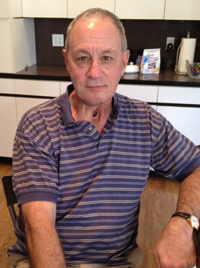Laryngeal Cancer Survivor
Survivor focuses on today
 Tom Moore was diagnosed with laryngeal cancer in 2009 when he was 61 years old after he began noticing problems with his speech.
Tom Moore was diagnosed with laryngeal cancer in 2009 when he was 61 years old after he began noticing problems with his speech.
Prior to my diagnosis, I was in such good health that I hadn’t been in a doctor’s office for 30 years. I was a smoker and know now that it was part of the problem, but when I was diagnosed with cancer, it was a shock.
In the summer of that year, I was having trouble talking and my voice was giving out. I have been a trial lawyer for 41 years, and losing your voice is a detriment in my profession. I went to an internist, who quickly referred me to an ear, nose and throat specialist.
The ENT did an examination and ordered a CT scan. The results showed an ugly growth on the front of my vocal chords, and the follow-up biopsy indicated it was malignant—Stage II. I then saw a radiation oncologist and he prescribed radiation therapy, which had an 80 to 85 percent success rate for my diagnosis. I had radiation treatments for two months, but because I felt well enough to work every day, the initial shock subsided.
My life was normal through the next year and a half, but in February 2011, cancer was discovered again in the same place. The doctors and I were both surprised.
Radiation wasn’t an option this time, and I was referred to an oncologist at our city’s NCI-designated cancer center. After a complete review, he told me it would be necessary to do a complete laryngectomy—I would lose my vocal cords. It was very frightening but necessary to stay alive. Three months later, I had the 12-hour surgery.
I began a new part of my life. At first, it was particularly difficult because I now had a hole in my neck – initially required a feeding tube – and I couldn’t speak. Communication was challenging because I could not converse and had to write down everything.
In the beginning I used a device called an electrolarynx to help me speak, which I held up to my throat. A few months later, a voice prosthesis was inserted in a small passage created between my trachea and esophagus. When I cover the hole (stoma) in my neck with my thumb, air is forced in the esophagus and up through my mouth as I talk. That’s how I speak now, and I continue to improve with practice.
The next February, however, my doctors discovered that the cancer had returned in two different spots in my throat and were confirmed as malignant. This was extremely disappointing, but I knew I had to keep believing that God wouldn’t give me more than I could handle.
A second major surgery ensued. My surgical team opened up the side of my throat and removed the two tumors. Then they used my right pectoral muscle to rebuild my throat and took a skin graft from my left thigh. I had a few complications, but with good nursing support and my family’s encouragement, I recovered over the next two months. Adjuvant low-dose radiation treatments followed.
As was my habit, I was back in the office as soon as possible, and because I greatly enjoy my work, it helped me focus on other things. I am back to walking every day and feel as well as I have in two years. My two sons, two daughters and six grandchildren have played a significant role in my continuing recovery.
My best advice is to live as normally as possible, just like it never happened. There are no guarantees that the cancer won’t come back, but I trust my doctors, have faith in God and live one day at a time. I encourage you to do the same thing and remember that each day is a good day.


